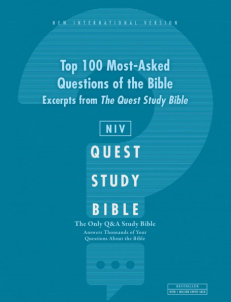
How to Read the Bible Chronologically
Christians have a special relationship with the Bible. It’s not a just book we read once and set aside. It’s one that we hopefully come back to regularly for knowledge, inspiration, and guidance.
The challenge we face is in maintaining constant exposure to Scripture without developing a “been-there-read-that” mentality. Finding new ways to approach the Bible prevents us from the kind of familiarity that makes reading it a chore.
Reading the Bible chronologically can be a refreshing way to see it through new eyes. We might think that because the Bible starts with creation and ends with Revelation it’s already laid out sequentially, but it’s not. Reading it in the order that events occurred can equip us to understand its narrative more clearly, and see it from a fresh perspective.
Why Isn’t the Bible Arranged Chronologically?
It’s important to remember that the Bible is a collection of writings. No one sat down and said, “Let’s write the Bible from start to finish.” The scrolls that make up the books of the Bible were written by more than 30 authors and accumulated over thousands of years.
These books were laid out by literary genre:
- The books of Moses (Genesis through Deuteronomy)
- The books of history (Joshua through 2 Chronicles)
- The books of wisdom (Job through Song of Songs)
- The prophets (Isaiah through Malachi)
- The Gospels (Matthew through Acts)
- The epistles (Romans through Jude)
- Final prophecy (Revelation)
At the beginning, the Bible is in chronological order. If you read the books of Moses in the order that they appear, you’re reading biblical history in its proper sequence. And of course, the Old Testament is chronologically before the New Testament. But eventually you’ll come to places where timelines weave together or overlap. And there is benefit to this arrangement, as for example stopping to read a prophet can give you insight into a historical narrative, and reading one of Paul’s epistles can clarify events in the story of Acts.
Why a Chronological Reading Can be Fun and Insightful
Nearly everyone knows the story of David and Goliath, but what if you could hear David talk about that story from his perspective? You can! Psalm 151 is a short Psalm (not included in the standard Hebrew Bible or our Old Testament, but it can be found in the Deuterocanonical books or online) where David discusses defeating Goliath and taking away Israel’s disgrace.
What if you could gain insight into Nathan’s confrontation with David over Bathsheba? Reading Psalm 51 after 2 Samuel 12 gives you a touching look at the extent of David’s repentance. It also connects a clear cause-and-effect relationship between Nathan’s rebuke and David’s response. Here’s a potential chronology for each Psalm.
Like most of the prophets, it’s easy to read the book of Amos as a free-floating prophecy without understanding its placement in the Israelite narrative, but 2 Kings 14:23–29 gives it an anchor. Reading Amos’ prophecy where it occurs historically (Amos prophesied during the reign of Jeroboam) contextualizes the prophet’s words.
That’s why reading the Bible chronologically offers new insights and perspectives into passages you may already be familiar with.
Bible Gateway provides a helpful chart for discerning where the books of the Old Testament prophets would have landed in Israel’s timeline.
Reading the Epistles with Acts
Over 25 percent of the New Testament was written by the apostle Paul, and all of his letters fit into the narrative Luke provides in Acts. Reading Paul’s epistles as we read alongside his missionary journeys can give us a new appreciation for his relationship to these churches and their backstory.
In Acts 17, we read about some of the struggles Paul went through in planting the church at Thessalonica. This provides a perfect backdrop for reading his first and second letters to the Thessalonian churches.
BlueLetterBible.org provides a helpful chronology of the New Testament starting with the second chapter of Acts.
A Chronological Reading Plan
If you’re wondering where to get started reading the Bible chronologically, check out a few of the links above. You can also check out the chronological edition of the NIV Once-A-Day Bible: Chronological ebook Edition, which breaks up the Bible into 365 sequential readings in chronological order making it an ideal one-year Bible reading plan.
Another great resource is the NIV Chronological Study Bible that presents Scripture in chronological order with notes, articles, and full-color graphics that connect the reader to the history and culture of biblical times.
You can also look at this one-year reading plan from BlueLetterBible.org.
Gaining a Firmer Grasp on Scripture
If you want to develop a better understanding of the Bible and God’s story of salvation, reading the Bible chronologically will help. You’ll increase your appreciation for God’s patience and love for his people and reinforce a deeper admiration for God’s story—and your place in it!






